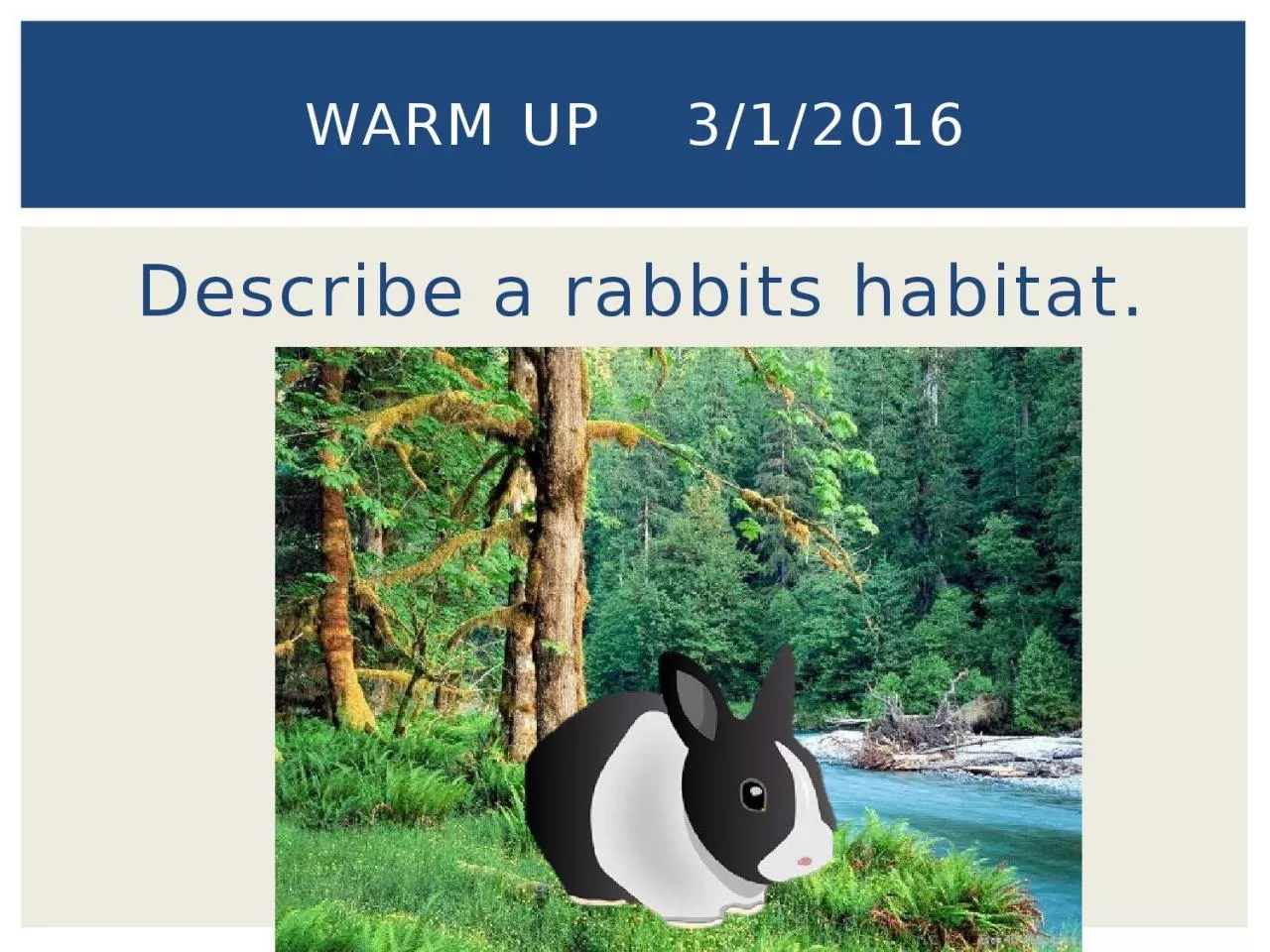

Warm Up 312016 Ecological Succession Describe succession with 80 accuracy utilizing class materials Describe the difference between primary and secondary succession with 80 accuracy utilizing class materials ID: 1026814
Download Presentation The PPT/PDF document "Describe a rabbits habitat" is the property of its rightful owner. Permission is granted to download and print the materials on this web site for personal, non-commercial use only, and to display it on your personal computer provided you do not modify the materials and that you retain all copyright notices contained in the materials. By downloading content from our website, you accept the terms of this agreement.
1. Describe a rabbits habitat.Warm Up 3/1/2016
2. Ecological Succession
3. Describe succession with 80% accuracy utilizing class materials. Describe the difference between primary and secondary succession with 80% accuracy utilizing class materials.Objectives
4. What is a habitat? A place where organism’s liveWhat is a population? A group of individuals of the same species in a particular location What is a community? All of the populations of a species in a given area What is an ecosystem?The community (abiotic and biotic) including the Earth’s atmosphereReview
5. What is ecological succession? The gradual process by which ecosystems change and develop over timeNothing remains the same forever Habitats are constantly changing Ecological Succession
6. In groups of three, you will use color to display the important parts of your given slide.Add any relevant information from the textbook to help.Use certain colors to emphasize vocabulary, key points, etc. Provide images to help visualize points.Your work will be the notes for the class!You will have 7 minutes to complete this.Flare it Up!
7. There are two main types, primary and secondary Primary SuccessionThe series of community changes which occur on an entirely new habitatFor example: after a volcano erupts primary succession will occur Ecological Succession
8. There are two main types, primary and secondary Secondary SuccessionThe series of changes which take place on a previously colonized, but disturbed or damaged habitat For example: a dead tree Ecological Succession
9. Succession can occur on many different timescales Timescales can range from a few days to hundreds of yearsFor example: Succession in a cow pie (pile of cow poop) takes about 3 monthsSuccession in a woodland may take hundreds of yearsSuccession Timescales
10. The environment does not remain the same foreverAs the environmental conditions change over time succession occursEach species is adapted to survive, thrive, and compete best against other species under a very specific set of environmental conditionsThe succession of plants controls the succession of animalsWhy does succession occur?
11. Changes in the plant species in an area is the driving force behind the changes in animal species. Each plant species will have an animal that feeds on it. As these plants change the animals will then change along with itPlants are in control
12. Pioneer plant species are species that grow best where there is little competition for space and resourcesBare ground is the ideal location for the establishment of pioneer plants Pioneer plants are typically small and low to the ground such as moss and algae Pioneer plants mainly grow in primary succession areasPioneer Plants
13. Primary succession occurs in an area that has never been colonized For example: As part of the natural sequence of life, trees mature and eventually die. When they fall to the ground, an opening is provided in the land and the process starts all over again on that new opening. The species which colonize the opening will be different than the original bare ground pioneers because the environmental conditions have been alteredThere is a different starting point Primary vs. secondary
14. Secondary succession occurs in an area that has previously been colonized but is damaged For example: As part of the natural sequence of life, trees mature and eventually die. When they fall to the ground, an opening is provided in the land and the process starts all over again on that new opening. The species which colonize the opening will be different than the original bare ground pioneers because the environmental conditions have been alteredThere is a different starting point Primary vs. secondary
15.
16.
17.
18. Much quicker than primary succession There are suitable seeds in the soil Remaining plant parts (stumps, roots, etc.) can rapidly regenerateFertility and structure has already been modified by organisms to make it more suitable for growth and colonization Secondary Succession
19. Video/Game
20. Ecology Relationships
21. Describe possible ecological relationships between species that live in close proximity to each other with 80% accuracy utilizing class materials.Define symbiotic relationships as mutualistic, parasitic, or commensalistic with 80% accuracy utilizing class materials.Classify symbiotic relationships with 80% accuracy utilizing class materials.Objectives
22. Look at the words on the board Brainstorm what types of ecological and symbiotic relationships you think the terms describe
23. Competition – when two or more organisms rely on the same environmental resources Predation – behavior of one animal feeding on another Symbiosis – the close relationship of two dissimilar organisms Mutualism – a symbiotic relationship where both organisms benefit Commensalism – a symbiotic relationship where one organism benefits and the other does not benefit but is unharmed Parasitism – a symbiotic relationship where one organism benefits and one is harmed Vocabulary
24. http://education.nationalgeographic.org/activity/ecological-relationships/National Geographic